
“Ai – Ki” – “Ai (Love) – Ki”
Morihei Ueshiba and Aiki, both Technical and Spiritual
The dichotomy between Aiki as a technical principle and Aiki as a spiritual principle has come up in a number of conversations recently, but I suspect that this has been a matter of discussion since Taisho year 14 (1925), upon Morihei Ueshiba’s spiritual experience after defeating a young naval officer’s attack with a bokuto (bokken):
武道の根源は、神の愛–万有愛護の精神–であると悟り得て、法悦の涙がとめどなく頬を流れた。
I attained the realization that the source of Budo is the love of the Gods, the spirit of Universal Loving Protection, and tears of ecstasy streamed endlessly down my cheeks.
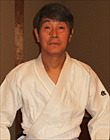
Takashi Sasaki Sensei (佐々木貴)
Here’s a comment from Takashi Sasaki Sensei on the importance of understanding Aiki:
合気道とは合気を追求する「合気之道」であることは容易に分かるが、それでは追求すべき「合気」とは何かとなると、なかなか難しい。その為か、たいがいは 「合気」が何かが分からなくても、初めの内は合気道の稽古はできるから、知らなくてもいいと思うのか、とりあえずは考えずに稽古を続けるようである。
しかし、本格的に「合気之道」を進もうとすると、どうしても「合気」について研究しなければならなくなる。何故ならば、「合気」は合気道の道の目標であるので、稽古の対象になる目標を明確にしなければ、稽古が正しい方向に進まないことになるからである。
Aikido can be simply understood as the “Way of Aiki” (合気之道), the pursuit of Aiki, but understanding exactly what the Aiki is that we ought to be pursuing can be rather difficult. For that reason, or perhaps because we can generally practice Aikido in the beginning without understanding what Aiki is, we think that we don’t need to know what it is and continue to train in the meantime without thinking about it very much.
However, as we begin to make serious progress on “The Way of Aiki” it is essential that we research into the meaning of Aiki. The reason for this is that, since Aiki is the goal of the Way of Aikido, if you do not make the goal of your training clear than your training will not progress in the correct direction.
Takashi Sasaki entered Aikikai Hombu Dojo in 1962 and received a Ni-Dan directly from Aikido Founder Morihei Ueshiba. You may remember him from the article “The Secret of Aikido is love?“. From Sasaki’s thoughts on Love in Aikido you can see that, like Morihei Ueshiba, he places great importance on the concept of Love.
Ueshiba himself seems to view his version of Aiki as something different, a break from times past, and intimately connected with “Love”:
「合気」という名は、昔からあるが、「合」は「愛」に通じるので、私は自分の会得した独特の道を「合気道」とよぶことにした。
したがって、従来の武芸者が口にする合気と私の言う合気とはその内容が根本的に異るのである。
The term Aiki has existed since ancient times, but since “Ai” (合) leads to “Love” (愛), I have chosen to call this unique Way that I have mastered “Aikido”.
This means that the substance of the Aiki that the warriors of old spoke of and the Aiki that I speak of are fundamentally different.
(*Note: read more about the issue of the naming of Aikido in “Aikido ™ – Can it really be trademarked?“)
But what about Aiki without Love? Typically, this is the usage that you will encounter in Daito-ryu – Aiki as a specific technical method.
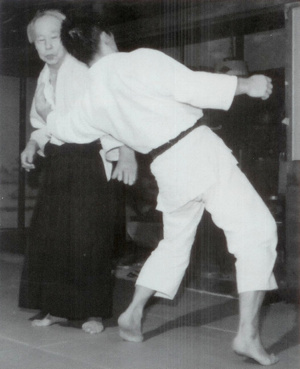
Yukiyoshi Sagawa demonstrates Uki-age no Aiki (浮揚之合気) on Masaru Takahashi
For example, in “Strange, Odd and False Theories of ‘Aiki’” we saw some thoughts from Masaru Takahashi, a Daito-ryu instructor and student of Yukiyoshi Sagawa, on some of the current explanations being floated concerning Aiki. He makes it clear that, in his opinion and experience, Aiki has nothing to do with Love, that nothing could be further from the truth, and that Aiki is at heart a core technical principle of Daito-ryu.
Is it also a core technical principle of Morihei Ueshiba’s art of Aikido?
In this very interesting study by John Driscoll, originally published on AikiWeb, the almost exact correlation between the techniques taught by Morihei Ueshiba and the techniques of the Daito-ryu Hiden Mokuroku shows the continuing technical links between the two arts.
I point this study out to note the continuing technical links, not to argue that Aiki is dependent upon a specific technical curriculum. However, it does show a continuing technical legacy between the Aikido of Morihei Ueshiba and Daito-ryu Aiki-jujutsu.
What about those who argue that Morihei Ueshiba gave up or somehow radically altered that technical legacy? Well, the study above is rather telling in and of itself, but then you also have the fact that virtually all of the technical demonstrations of Aiki given by Morihei Ueshiba were duplicated (or perhaps even exceeded) by his peers in Daito-ryu.
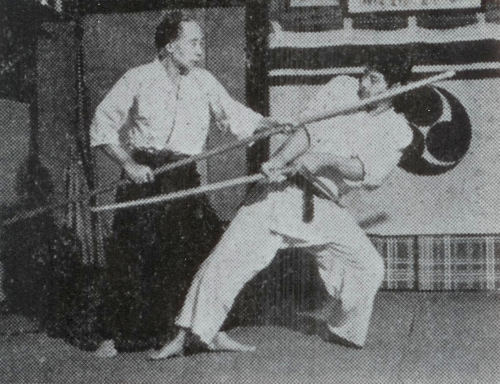
Yukiyoshi Sagawa demonstrates the spear
– from “Hiden Nihon Jujutsu” (秘伝日本柔術)
Note the mitsudomoe symbol on the curtain in the background
Then, there’s this – around 1956 Morihei Ueshiba O-Sensei himself thought that what Daito-ryu Aiki-jujutsu instructor Yukiyoshi Sagawa was teaching was close enough to Aikido that he invited Sagawa to become an instructor at Aikikai Hombu Dojo. Although the arrangement was eventually refused by Sagawa, the fact that the offer was made and sanctioned by the Founder should say something important about the continuing technical connections between Ueshiba’s art and the original Daito-ryu.
Now, let’s look at how Hakaru Mori (森恕), Somucho (“Director” / 総務長) of the Daito-ryu Aiki Jujutsu Takumakai (大東流合気柔術琢磨会) describes Aiki as a technical principle:
合気とは、相手の無意識の(本能的な)動きを誘い出す技術である。
Aiki is to draw forth the opponent’s unconscious (instinctive) movement.
Compare that to this description of Aiki by Morihei Ueshiba (via Takashi Sasaki):
『合気』というものは相手の防御本能を刺激して、(相手から)本能的な無意識の動きを引き出す技術である。
Aiki is a technique to stimulate the opponent’s defensive instincts, and draw out instinctive unconscious movement (from the opponent).
So, let’s assume for the moment that Morihei Ueshiba did not make a radical departure from the core principles of the only art other than his own that he was licensed to teach, the only art other than his own that he issued licenses in, the only art that he trained in for any significant amount of time – more than twenty years. How does that fit in with his assertion that “the substance of the Aiki that the warriors of old spoke of and the Aiki that I speak of are fundamentally different”?
Well, he didn’t get to the spiritual heights from nowhere, and there is a reason that he was still teaching a physical method while preaching a spiritual and philosophical ideal. Moriehei Ueshiba found his way to the spiritual side of Aiki that he quoted so often through the technical method, and this was the basis and the engine for his spiritual training:
私は合氣道より他にこの世を立て直す方法はしらないであります。
I know of no other way to rebuild the world than through Aikido.
Before you ask, no – I don’t believe that he’s saying that Aikido is the only way to better the world. I do think that, if you read the quote in the context of “Take Musu Aiki”, that he means that that this is the only method through which he himself was able to find the way to “rebuild the world”. He also notes in other places that he arrived at this understanding through training:
合気道の極意を会得した者は、宇宙がその腹中にあり、「我は即ち宇宙」なのである。私はこのことを武を通じて悟った。
“I am the universe”, one who was grasped the secret of Aikido has the universe within them. I came to this realization through the art of war.
In this context the section below from “Take Musu Aiki” begins to become clear:
私の武産の合気は、宗教から出て来たのかというとそうではない。真の武産から宗教を照らすのです。未完の宗教を完成へと導く案内であります。
It would not be correct to say that my Takumusu Aiki emerged from religion. True budo illuminates religion. It guides incomplete religion to completion.
Here we again see Morihei Ueshiba emphasizing that Aikido was not born from religion. We also see Ueshiba implying that the practice of this Budo provides something can be missing from religion – that is, the bridge between the practical, physical world and the spiritual, religious world.
This is where we come to what Ueshiba considered to be his sea change:
今迄の合気が肉体の技を重視した魄の武術なのに対して、「武産合気」は、精神性を重視した魂の術なのだ。
In contrast with the “spiritual” Bujutsu of the past which emphasizes physical techniques, “Take Musu Aiki” is a “spiritual” method that emphasizes spirituality.
You may notice that “spiritual” appears on both sides of the equation – confused yet?
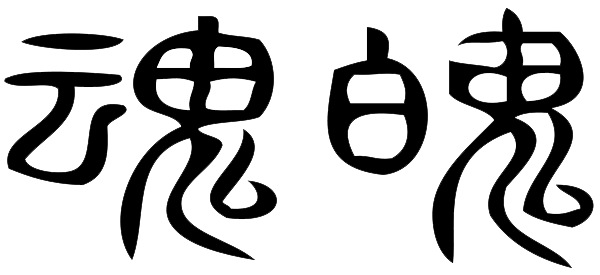
Hun-Po / Kon-Paku (魂魄)
Actually, he used two different Kanji, the first of which means “spirit” or “soul”, and the second of which means…”spirit” or “soul”. There are two souls in Chinese cosmology – the “Hun” (魂 / “Kon”) soul, which is associated with Yo (Yang) and the intellect, and the “po” (魄 / “haku” or “paku”) soul, which is associated with In (Yin) and the body.
So, we might say that he is moving from a physical to a spiritual expression of Aiki – except that’s not really what I’m saying.
In the case above he’s speaking about a change in purposes – in other words, saying the same tools of Aiki training that produced the physical effects that he and many others became famous for can also be used to produce spiritual effects, if that is your goal and your intent.
This becomes clear as we read through the context in which these statements are made, in which he states (with great repetition) the relationship of the two souls in classical Chinese terms, in terms of Yin and Yang. Morihei Ueshiba spoke about Yin-Yang (or rather In-Yo) incessantly, both explicitly and implicitly – of course, Yin-yang is the basic model of Chinese metaphysics and the Chinese martial arts.
In the Chinese metaphysical model, the two souled Kon-Paku (Hun-Po) structure is one example of an In-Yo (Yin-Yang) dynamic – two opposing, but interrelated and interdependent aspects. In a trained state the Haku/physical aspects of our lives support and protect the Kon/spiritual aspects.
In the same vein, according to Morihei Ueshiba:
魄の中に神が入り、魄を育て魄は魂を守るのです。
The spirit enters and nurtures the physical (Haku) and protects the spiritual (Kon).
(*Note: there is an implied relation here to the Chinkon Kishin exercise, but I won’t go into that at this time)
The basic goal of the dynamic under this model is seen as being to harmonize these two forces for health, balance in your life and…self-realization – leading to to a direct experience of heaven on earth, united by man.
合気道は地上天国建設への羅針盤である。
Aikido is a compass pointing towards the establishment of heaven on earth.
(*Note: there is more information about Ueshiba and heaven-earth-man available from the links at the bottom of this article)
In Chinese and Taoist culture there are a number of common methods for achieving this refinement of the two souls, including arts such as Taiji and other Internal Chinese Martial Arts.
It’s one thing to talk about universal love and peace – but how do you get there? And while you’re on your way, how do you stay on track? How do you get to the universe without flying off into outer space?
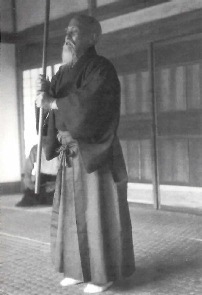
Morihei Ueshiba O-Sensei shows Kagura-mai (神楽舞 / “dance of the gods”)
「神楽舞の始めは「天の浮橋に立たして」であり「むすび」の象徴。 合気道は、どうしても天の浮橋に立たねばなりません。
The beginning of Kagura-mai is to stand on the Floating Bridge of Heaven, the personification of connection (“musubi”). No matter what, Aikido must stand on the Floating Bridge of Heaven.
For Morihei Ueshiba the answer lay in the spiritual expression enabled by the technical training in Aiki that he received from Sokaku Takeda.
The two are tied together intimately.
So much so that to ignore it is to cut yourself off from the very methods that Morihei Ueshiba himself employed to reach towards his goals.
- For a discussion of a specific technical definition of Aiki as a technical principle see “Aikido without Peace or Harmony“.
- To see a presentation of Morihei Ueshiba’s basic training model, and what it means see “Aikido and the Floating Bridge of Heaven“.
- To see another example of spiritual repurposing of the technical principle of Aikido see “Aiki Budo is the Way of Human Development“.
Christopher Li – Honolulu, HI







Leave a Reply